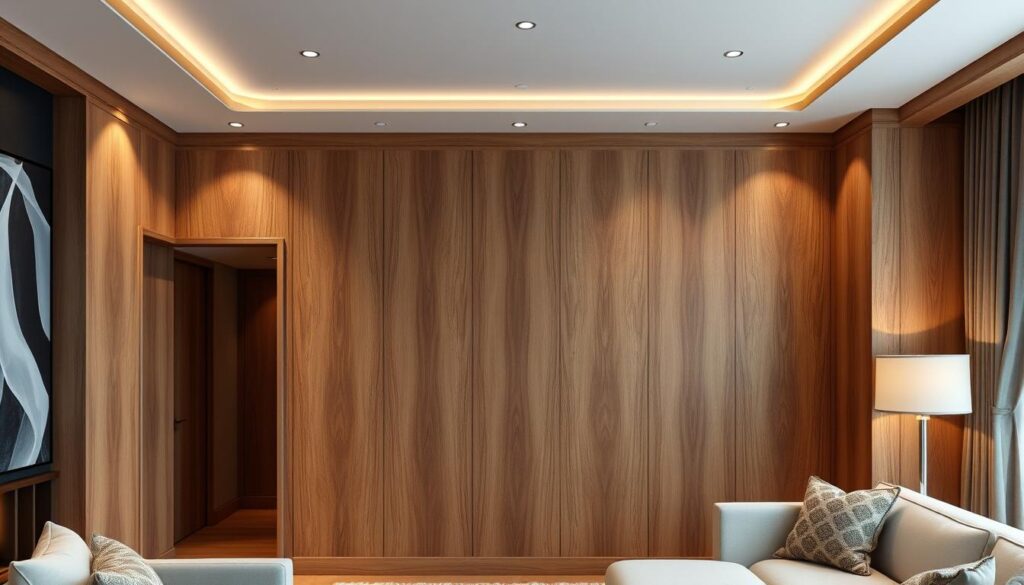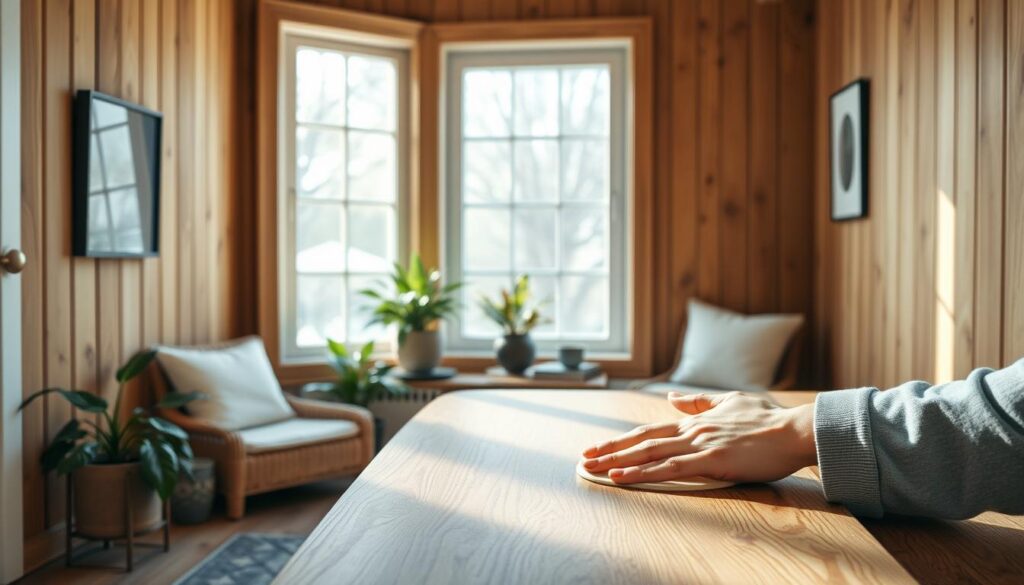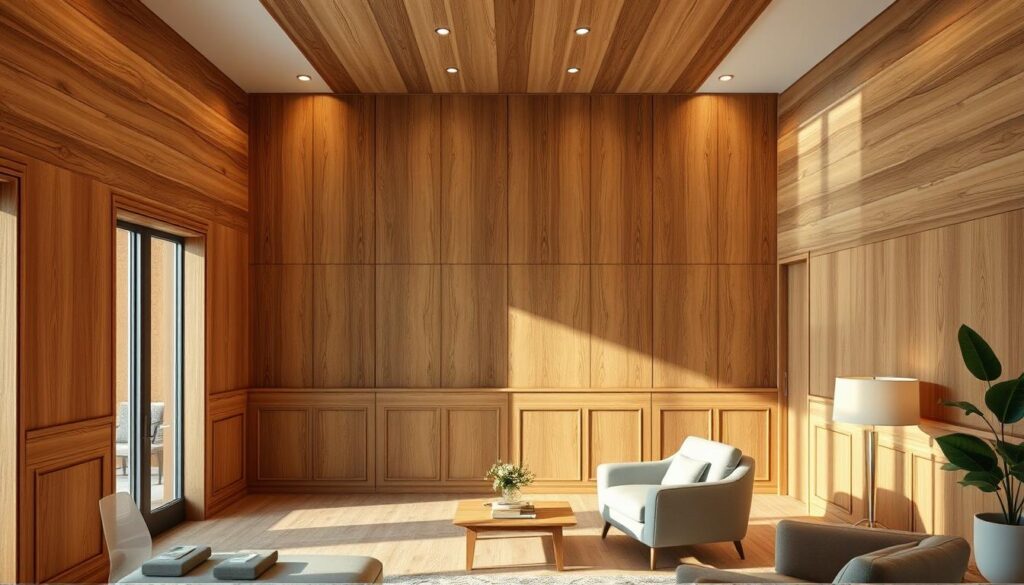Transform your walls with premium oak tongue and groove paneling. Create a timeless, elegant look while adding natural warmth and character to your living spaces
Make your living spaces more elegant and warm with premium oak wall panels. These panels are made from top-quality wood. They come in a tongue and groove design, perfect for changing your home’s look. You can choose from cozy, rustic to modern, sleek designs, matching your style.
Oak is known for being very durable. It’s great for interior design and home improvement that lasts. See how premium oak tongue and groove paneling can make your home look better and feel more welcoming.

Key Takeaways
- Premium oak tongue and groove paneling offers timeless elegance and natural warmth to transform your living spaces.
- Oak is a highly durable hardwood species, making it an excellent choice for long-lasting interior design projects.
- Tongue and groove construction provides a seamless, interlocking system for effortless installation and a cohesive, polished look.
- Versatile design possibilities allow you to create a cozy, rustic charm or a sophisticated, modern aesthetic with oak paneling.
- Investing in high-quality oak wall panels can add value and enhance the overall appeal of your home.
Understanding Oak Tongue and Groove Paneling Systems
Oak wood paneling brings warmth and charm to any home. It comes in classic white oak and rich red oak tones. The magic is in the interlocking panels and wood joinery of the tongue and groove system.
Types of Oak Wood Species for Paneling
Oak is a durable hardwood loved for its grain patterns. For paneling, white oak and red oak are top picks. White oak has a light tone and subtle variations. Red oak has a pronounced grain and a warmer hue.
The Interlocking Mechanism Explained
The tongue and groove system is a proven method for oak paneling. It ensures a secure, seamless installation. The panels have a tongue that fits into a groove, creating a stable and cohesive surface.
Benefits of Tongue and Groove Construction
- Enhances structural integrity and stability of the wall system
- Facilitates a seamless, interlocking panels installation for a clean, professional look
- Allows for wood joinery that minimizes gaps and inconsistencies
- Promotes a seamless installation process, reducing the need for extensive finishing work
Knowing about oak species and tongue and groove benefits helps homeowners choose the right white oak or red oak paneling.
Design Possibilities with Premium Oak Wall Panels
Unlock endless design potential with premium oak wall panels in your home. These wood accents blend rustic decor and interior styles perfectly. They add timeless charm and natural beauty to any space.
Oak tongue and groove panels are great for accent walls or ceiling panels. They bring depth and texture to your rooms. See how they can make your bedrooms, bathrooms, and home offices feel more sophisticated and warm.
Whether you like classic or modern styles, oak panels fit your taste. Let your creativity shine and find new ways to use these panels in your dream home.
“Oak tongue and groove paneling is a game-changer for any space. It’s versatile, going from rustic to modern. It’s perfect for adding warmth, texture, and character to your home.”
Oak panels offer endless design options. Try different patterns like board-and-batten or herringbone. Mix installation techniques, finishes, and colors to match your style and home’s look.
Let oak’s natural beauty be the centerpiece of your design. Make your living spaces elegant and appealing with premium oak wall panels.
Quality Standards and Grades of Oak Wall Paneling
Choosing the right oak wood paneling for your home is key. Knowing the quality standards and grades is important. The difference between kiln-dried oak in a clear grade or a select grade affects the look, durability, and value.
Premium Grade vs Standard Grade Oak
Premium grade oak paneling has no knots, blemishes, or imperfections. It looks clean and uniform. This “clear grade” oak is prized for its beauty and consistent grain.
Standard grade oak, on the other hand, has more character. It might have small knots and minor variations. This makes it a budget-friendly choice for a rustic look.
Moisture Content and Stability Factors
The right moisture content is key for stable oak wall panels. Kiln-dried oak has controlled moisture. This makes it less likely to warp, cup, or shrink over time.
Surface Finish Options
You can choose from different finishes for your oak paneling. An oil finish highlights the wood’s natural beauty. A lacquer finish gives a sleek, modern look and extra protection.
| Feature | Premium Grade Oak | Standard Grade Oak |
|---|---|---|
| Appearance | Uniform, clear grain | More character, with small knots and variations |
| Stability | Highly stable due to kiln-drying | May be more prone to warping or shrinkage |
| Finish Options | Oil, lacquer | Oil, lacquer |
| Cost | Higher | Lower |
Understanding the quality standards and grades of oak wall paneling helps you make a smart choice. It ensures your design goals, budget, and expectations are met.
Installation Guide for Oak Tongue and Groove
Turning your space into a premium oak tongue and groove paneling masterpiece needs careful planning. You can do it yourself or hire pros. Let’s look at the key steps for a smooth installation.
Preparing Your Walls
Start by making sure your walls are clean, dry, and even. Fix any bumpy spots with sanding or a leveling compound. This step is crucial for a solid base.
Acclimating the Panels
Oak tongue and groove panels need time to adjust to your space’s humidity and temperature. This prevents warping or shrinking. Follow the maker’s advice for acclimation, usually 72 hours or more, before you start.
Necessary Tools and Equipment
- Circular saw or miter saw
- Hammer or nail gun
- Rubber mallet
- Measuring tape and pencil
- Wood glue
- Trowel or putty knife
- Safety gear (goggles, gloves, and dust mask)
With the right tools and prep, you’re ready for a DIY success or a pro’s touch.
Video source from youtube
“The key to a flawless oak tongue and groove installation is attention to detail and patience. Take your time, and the results will be truly rewarding.”
Remember, careful planning and detail are key, whether you do it yourself or get pros. With the right steps, your space will shine with premium oak paneling for years.
Cost Considerations and ROI for Oak Paneling
Thinking about oak tongue and groove paneling for your home? It’s key to look at the costs and its long-term value. From the oak paneling prices to the installation costs, knowing the financial side is crucial. This ensures it’s a smart long-term investment.
Material Pricing Factors
The price of oak paneling changes based on several things. The type of wood, its quality, and finish all play a part. Higher-quality oak panels cost more but last longer and look better. The price per square foot also changes with location and market trends.
Installation Cost Variables
- Labor costs for professional installation
- Preparation of the wall surface
- Specialized tools and equipment required
- Potential need for additional materials like trim or finishing touches
Long-term Value Assessment
The upfront oak paneling prices and installation costs might seem steep. But, oak’s lasting quality and classic look can boost your home’s value. This makes it a solid return on investment in the long run.
| Factor | Potential Impact |
|---|---|
| Durability | Oak paneling can last for decades with proper maintenance, reducing the need for frequent replacements. |
| Aesthetic Appeal | The classic look of oak can enhance the overall appeal and value of your home, attracting potential buyers. |
| Energy Efficiency | Oak’s natural insulating properties can contribute to improved energy efficiency, leading to long-term cost savings. |
By weighing the oak paneling prices, installation costs, and the potential home value increase and long-term investment, homeowners can make a smart choice. This choice can enrich their living spaces with a timeless material.
Maintenance Tips for Oak Panel Longevity
Keeping your oak paneling looking great is key to enjoying your home for a long time. Simple wood care and cleaning can protect your investment. This way, your oak panels will stay beautiful for many years.
Routine Cleaning and Dusting
Cleaning your oak panels regularly is crucial. Use a soft, dry cloth to dust them gently. This removes dirt and keeps them looking good. Never use water or harsh chemicals, as they can harm the wood.
Occasional Refinishing
Even with good care, oak panels might need a light refinish now and then. Choose a high-quality refinishing product for tongue and groove paneling. Follow the instructions carefully to keep the wood’s natural look and feel.
Protecting Against Moisture
Moisture can damage oak wood, causing it to warp or crack. Keep your home’s humidity levels stable. Fix any leaks or spills quickly to protect your panels. Using a dehumidifier in damp areas can also help.
| Maintenance Task | Frequency |
|---|---|
| Routine Dusting | Weekly |
| Light Cleaning | Monthly |
| Refinishing | Every 3-5 Years |
| Humidity Control | Ongoing |
By sticking to these maintenance tips, you can keep your oak paneling looking great. It will remain a beautiful and functional part of your home for years.

Environmental Benefits of Oak Wood Paneling
Oak wood paneling is great for eco-friendly interiors. It’s a sustainable and renewable material. It has many environmental benefits.
Sustainability Certifications
Many oak wood products for paneling have FSC and PEFC certifications. These groups check if the wood comes from sustainable forests. This helps keep our forests healthy.
Carbon Footprint Considerations
Oak wood lasts a long time, making it a good choice for interiors. It has a lower carbon footprint than many synthetic materials. This makes it a popular choice for eco-friendly interiors and sustainable living.
| Certification | Description |
|---|---|
| FSC Certification | The Forest Stewardship Council (FSC) is a global non-profit organization that promotes responsible sustainable forestry. FSC-certified products ensure the wood is sourced from well-managed forests. |
| PEFC Certification | The Programme for the Endorsement of Forest Certification (PEFC) is an international non-profit organization that sets standards for sustainable forestry practices. PEFC-certified oak paneling guarantees environmentally-friendly sourcing. |
“Using sustainably sourced oak for interior paneling is an excellent way to reduce your carbon footprint and contribute to a more sustainable forestry industry.”
Comparing Oak Tongue and Groove to Alternative Materials
Homeowners have many choices for wall paneling, but oak tongue and groove stands out. Engineered wood, laminate panels, vinyl planks, and MDF paneling have their benefits. Yet, solid wood like oak offers unmatched advantages.
Engineered wood is cheaper but can’t compare to oak’s beauty and durability. Laminate and vinyl planks are easy to put up but can’t replicate the real feel of hardwood. MDF paneling is flexible but doesn’t have oak’s strength and long-term value.
- Engineered wood: Cost-effective but lacks the natural charm of oak
- Laminate and vinyl: Convenient installation but lacks the authenticity of solid wood
- MDF: Versatile but may not offer the same structural stability as oak
The solid wood benefits of oak tongue and groove paneling are clear. It’s incredibly strong, resists warping, and boosts a home’s value. With the right care, it can make any room look and feel better for years.
“Oak tongue and groove paneling is the gold standard for timeless, high-quality wall treatments. Its natural beauty and durability are unmatched by alternative materials.”

Considering different wall paneling options, oak’s lasting value and beauty make it a smart choice. It’s a great way for homeowners to improve their living spaces.
Where to Source Premium Oak Paneling
Looking for the best premium oak tongue and groove paneling for your home? You have a few choices. You might like shopping online or visiting local lumber yards. It’s key to find reliable suppliers who offer top-notch products.
Local vs. Online Suppliers
Starting with local lumber yards is a smart move. These places usually have lots of premium oak wood and can help you choose the right one. Plus, you can see the panels in person to check their quality.
If online shopping is more your style, many online wood retailers sell premium oak tongue and groove paneling. They offer a wide variety of species, finishes, and sizes. This makes it easier to find what you need.
What to Look for When Purchasing
Whether you shop locally or online, make sure to check the quality first. Look for detailed product info, like the wood type, grade, moisture level, and finish. Also, read customer reviews and ask for recommendations to get the best deal.
| Supplier Type | Advantages | Considerations |
|---|---|---|
| Local Lumber Yards | Personalized service and guidance Ability to inspect panels in person Support for local businesses | Limited selection compared to online Potential for higher prices Inconvenient for those without local access |
| Online Wood Retailers | Wider selection of products Convenient home delivery Ability to compare prices and reviews | Inability to inspect panels in person Potential for shipping delays or damages Uncertainty about product quality and authenticity |
By looking at both local and online options and focusing on quality, you can find the perfect premium oak tongue and groove paneling. This will beautifully transform your home’s interior.
Conclusion
Premium oak tongue and groove paneling is a great choice for your home’s interior. It brings natural beauty, durability, and versatility. These qualities offer many benefits that go beyond looks, making your home more valuable.
Looking to add warmth, boost energy efficiency, or enhance your home’s wood look? This paneling is a smart pick. Its high-quality craftsmanship and wide design options make it a wise investment for your home.
Ready to see how premium oak paneling can transform your home? Contact us at +6282332572828 or email info@timbertropics.com. Our team is here to help you achieve your dream home and make the most of your investment.
FAQ
What are the different types of oak wood species used for paneling?
White oak and red oak are the most common types for paneling. Each has its own grain, color, and properties. They suit different tastes and uses.
How does the tongue and groove construction system work?
The tongue and groove system connects panels smoothly. It creates a uniform look on walls. This method ensures a tight fit and hides gaps.
What are the benefits of using oak tongue and groove paneling?
Oak paneling is durable, beautiful, and versatile. Its hardness and stability make it great for walls. It also fits many interior styles well.
What are the differences between premium and standard grades of oak paneling?
Premium oak has clear boards and consistent grain. Standard oak may have more marks. Premium is higher quality but costs more.
How do I properly install oak tongue and groove paneling?
Start with wall prep and acclimating the wood. Use the right tools and follow instructions. DIY or hire a pro for a perfect finish.
What are the cost factors to consider when purchasing oak paneling?
Costs depend on grade, size, finish, and installation. Premium oak may cost more upfront but offers better value and durability.
How do I maintain the appearance of my oak paneling over time?
Clean regularly, protect from moisture, and refinish as needed. Follow care instructions to keep your oak looking great.
Where can I find high-quality oak tongue and groove paneling?
Look for it at local yards, specialty stores, or online. Check for certifications like FSC or PEFC for sustainable wood.
Related article : French Oak Hardwood Flooring – Premium Floors
